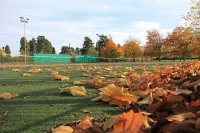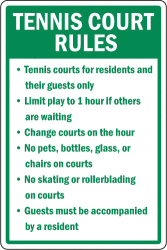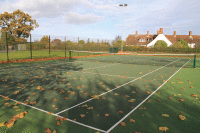Hard Surface Tennis Courts - Take them seriously!

Maintenance of tennis courts is often not taken seriously enough. I represent HC Courts, a tennis court maintenance company based in the Midlands and come across problems all of the time. So, we've put together a ten-point guide to help you keep your court in tip-top condition - from prevention of damage, all the way through to complete repairs.
Many different styles of tennis are being played across different surfaces. Hard and grass courts are the mainstay of the British game, encouraging a fast and intense game. Grass encourages a serve and volley type game. Grass is the fastest surface, and also one of the trickiest to maintain.
Hard courts offer consistent bounce and are great for beginners, however, the bounce can be a challenge for some.
You can amend the speed of your hard court at installation stage by defining how much sand to place in the top paint, however you can tweak the speed by increasing friction at a later stage if required.

1. Clean Your Court Regularly
This one should go without saying, but many court owners simply don't clean their courts regularly. We'd recommend cleaning your court every few weeks, particularly during times of heavy usage. A pressure washer is usually the tool of choice, but check the pressure you are going to use based on your surface type.
2. Damage Prevention
Damage prevention is an important thing to consider. Are you or your court users using the right kind of shoes, for instance? Assess the activity on your court, including elements such as chairs and items being dragged across the surface or users eating and chewing gum, for instance, to see whether these activities are damaging your surface.
3. Have Rules
Once you have assessed how people are using your court and have decided how to prevent damage, create a simple set of rules that you can display on signage around your court. This enables you to prevent any problems before they occur.
4. Fencing & Floodlights
Fencing is another important element, both in terms of keeping your court in good condition, and in terms of something that needs maintaining! We'd recommend having a fence around your court for a few reasons. Firstly, it means there is a lot less ball retrieval needed but, more importantly, it stops all kinds of potential court problems. Fences stop kids playing on the court, intrusion from animals, and any vehicles from driving onto court. Floodlights are another great addition. Not only do they increase the playable time on your court and increase visibility at night, they also make it easier to see any potential problems by illuminating your surface for a close inspection, and increase security at night by deterring kids from going on to your court.
5. Drainage
Do you have a proper drainage system installed on your court? Without one, any excess water may sit on the surface or just beneath, causing all sorts of problems. If you don't have a drainage system installed, we'd recommend one, but if you do we'd suggest you check it every week or two (particularly during wet weeks). You'll need to be checking for any blockages by leaves or debris that may be stopping your drainage system from working. Clear these regularly to keep everything in good condition. Another top purchase would be a leaf blower to move the leaves off your court regularly to stop any blockages occurring.

This is an often-overlooked task by tennis court owners. Whilst rain, in theory, clears your court of debris, if your surface is uneven at all, water can stand and cause damage. Dirt will accumulate in the standing water, and your surface will be damaged if left. During periods of rain, regularly check your court and gently brush any standing water away. If you do have lots of standing water regularly, you may be in need of court resurfacing.
7. Cleaning Equipment
It is essential to use the right cleaning equipment on your court to avoid damaging it when cleaning. Make sure you use a soft bristled brush, a pressure washer that is appropriate for your surface type, and the correct types of chemicals. Household bleaches or other consumer chemicals can be used, but check your court surface and how to dilute first to ensure no damage is done. It is key to ensure that you have the right tools ready to clean and maintain your court before it falls into a poor state. It is much easier to maintain a tennis court than it is to clean one.
8. Resurfacing & Repair
The worse case scenario is that your court needs resurfacing or repairing but, if this is the case, then don't hesitate as surface problems will only get worse once established. In general, your surface should last between six and eight years, however your surface can become uneven during this time due to a variety of under-surface reasons. It's always a great idea to get an inspection done or go over your court yourself in detail every year to check for signs that you may need to have some repair or resurfacing work completed.
9. Court Painting
Consider getting your court painted with non-slip, anti-fungal paint that is specialised for the job. After cleaning, most tennis courts are colour coated with a specially manufactured paint coating designed to define the playing areas in a bright and appealing way. Colour coating increases slip resistance, and finishes your court - it's well worth getting your court re-painted every few years.
10. Get Professional Help
If in doubt on any of the above points, get some expert help. Tennis court maintenance companies can give you an expert view to get any issues resolved before they make your court unplayable.
If you own or maintain a tennis court, you'll know the pleasure it can give and, by following our ten tips for tennis court maintenance, you can ensure that your courts are playable and in good health all year round.

Weekly: Perimeter areas, cabana areas and net lines should be cleaned
Monthly: Lines should be painted as needed. Check areas of heavy play (baselines and service boxes) for wear
Quarterly: Low end of the court should be cleaned and excess material removed as needed
Yearly: A professional tennis court construction company should conduct a complete maintenance surface checkout (colour treatment may be needed, structural crack repair, etc.)
